Music-Crash-Course-Key-Signatures-and-Major-Scales
Key Signatures
Pitches
All musical pitches have the same "distance" to next closest pitch. "C" has exactly the same relationship to the pitch just above it, "C#" (or "Db"), an ebony key on the piano keyboard, as "C#" has to the next pitch, "D".
Shown in these examples are two notes appearing at the same point in time (called and interval). Each vertical column contains intervals with same relationship.
Here are more examples, with larger intervals. Because these staves have a Brace (connected together with a line) they are to be performed at the same time. Again, each vertical column contains intervals with same relationship.
Major Scales
All of the notes in each of these scales have the same relationship to each other. Other Major Scales have the same relationship between pitches found in the "C Major scale", the "G Major scale" and the "F Major Scale".
With few exceptions, a piece of music, or a section of a piece of music, is said to be in "C Major" when most and sometimes all of the notes are contained in (from) a C Major scale. Often, most of the notes in a piece of music are better described as being from some other scale.
All other major scales except "C Major" have pitches which are produced on a piano keyboard with ebony keys. Sharps and Flats are used to indicate these pitches. As shown in the previous examples: "G Major" has a sharp which is used in front of the F; "F Major" has a flat is which is used in front of the B.
Signatures
Writing the Flats and Sharps contained in scales other than "C Major" can and is best avoided by using key signatures. Key Signatures appear at the beginning of each stave and tell the reader to always consider specific pitches to be Flats or Sharps unless otherwise indicated.
Key Signatures (Except for C Major) appear as sharps or flats at the beginning of each stave. These sharps and flats are placed on the staff in a specific order. Here are the Major key signatures as they appear in treble clef:
Notice how "F Sharp" and "G Flat" indicate the same pitches. Also "B" and "C Flat" / "C Sharp" and "Db".
All musical pitches have the same "distance" to next closest pitch. "C" has exactly the same relationship to the pitch just above it, "C#" (or "Db"), an ebony key on the piano keyboard, as "C#" has to the next pitch, "D".
Shown in these examples are two notes appearing at the same point in time (called and interval). Each vertical column contains intervals with same relationship.
 There are no pitches between E and F There are no pitches between E and F |
 G# (or Ab) is the only pitch between G and A G# (or Ab) is the only pitch between G and A |
 G# (or Ab) and A are the two pitches between G and Bb G# (or Ab) and A are the two pitches between G and Bb |
 There are no pitches between B and C There are no pitches between B and C |
 D# (or Eb) is the only pitch between D and E D# (or Eb) is the only pitch between D and E |
 F and F# (or Gb) are the two pitches between E and G F and F# (or Gb) are the two pitches between E and G |
 There are no pitches between F and Gb There are no pitches between F and Gb |
 F is the only pitch between E and F# F is the only pitch between E and F# |
 B and C are the two pitches between Bb and Db B and C are the two pitches between Bb and Db |
Here are more examples, with larger intervals. Because these staves have a Brace (connected together with a line) they are to be performed at the same time. Again, each vertical column contains intervals with same relationship.
 There are 6 pitches between A and E There are 6 pitches between A and E |
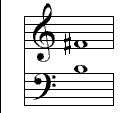 There are 9 pitches between F and Eb There are 9 pitches between F and Eb |
 There are 16 pitches between G and C There are 16 pitches between G and C |
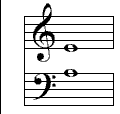 There are 6 pitches between Gb and Db There are 6 pitches between Gb and Db |
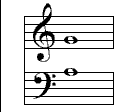 There are 9 pitches between A and G There are 9 pitches between A and G |
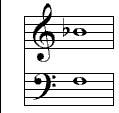 There are 16 pitches between F and Bb There are 16 pitches between F and Bb |
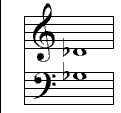 There are 6 pitches between B and F# There are 6 pitches between B and F# |
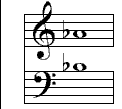 There are 9 pitches between Bb and Ab There are 9 pitches between Bb and Ab |
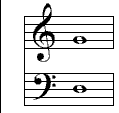 There are 16 pitches between D and G There are 16 pitches between D and G |
 These notes are not shown as intervals (it would be difficult to read all of these notes if they were placed one above the other), However the relationship between each note is important. The pitches these notes represent, in this order, are collectively called a "C Major Scale". On a piano keyboard, all of the pitches are performed with ivory keys. The scale begins and ends on C. There is one pitch between each note except for E to F and B to C. E is the third note in the scale, F is the fourth; B is the 7th note in the scale and C is the Eighth. These notes are not shown as intervals (it would be difficult to read all of these notes if they were placed one above the other), However the relationship between each note is important. The pitches these notes represent, in this order, are collectively called a "C Major Scale". On a piano keyboard, all of the pitches are performed with ivory keys. The scale begins and ends on C. There is one pitch between each note except for E to F and B to C. E is the third note in the scale, F is the fourth; B is the 7th note in the scale and C is the Eighth. |
 The pitches these notes represent, in this order, are collectively called a "G Major Scale". The scale begins and ends on G. There is one pitch between each note except for B to C and F# to G. B is the third note in the scale, C is the fourth; F# is the 7th note in the scale and G is the Eighth. The pitches these notes represent, in this order, are collectively called a "G Major Scale". The scale begins and ends on G. There is one pitch between each note except for B to C and F# to G. B is the third note in the scale, C is the fourth; F# is the 7th note in the scale and G is the Eighth. |
 The pitches these notes represent, in this order, are collectively called a "F Major Scale". The scale begins and ends on F. There is one pitch between each note except for A to Bb and E to F. A is the third note in the scale, Bb is the fourth; E is the 7th note in the scale and F is the Eighth. The pitches these notes represent, in this order, are collectively called a "F Major Scale". The scale begins and ends on F. There is one pitch between each note except for A to Bb and E to F. A is the third note in the scale, Bb is the fourth; E is the 7th note in the scale and F is the Eighth. |
All of the notes in each of these scales have the same relationship to each other. Other Major Scales have the same relationship between pitches found in the "C Major scale", the "G Major scale" and the "F Major Scale".
With few exceptions, a piece of music, or a section of a piece of music, is said to be in "C Major" when most and sometimes all of the notes are contained in (from) a C Major scale. Often, most of the notes in a piece of music are better described as being from some other scale.
All other major scales except "C Major" have pitches which are produced on a piano keyboard with ebony keys. Sharps and Flats are used to indicate these pitches. As shown in the previous examples: "G Major" has a sharp which is used in front of the F; "F Major" has a flat is which is used in front of the B.
Signatures
Writing the Flats and Sharps contained in scales other than "C Major" can and is best avoided by using key signatures. Key Signatures appear at the beginning of each stave and tell the reader to always consider specific pitches to be Flats or Sharps unless otherwise indicated.
Key Signatures (Except for C Major) appear as sharps or flats at the beginning of each stave. These sharps and flats are placed on the staff in a specific order. Here are the Major key signatures as they appear in treble clef:
 C C |
 C C |
 G G |
 F F |
 D D |
 B Flat B Flat |
 A A |
 E Flat E Flat |
 E E |
 A Flat A Flat |
 B B |
 D Flat D Flat |
 F Sharp F Sharp |
|
 C Sharp C Sharp |
 C Flat C Flat |

